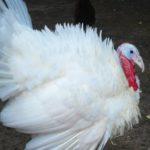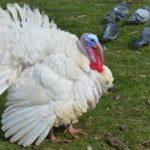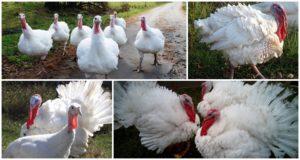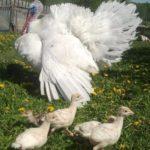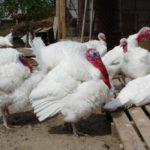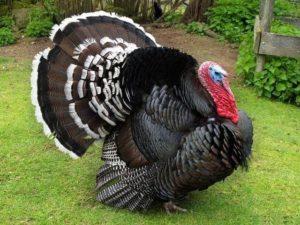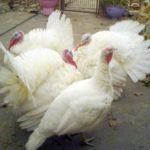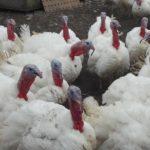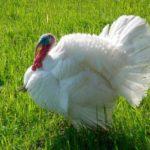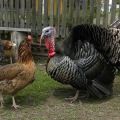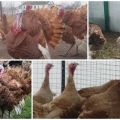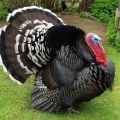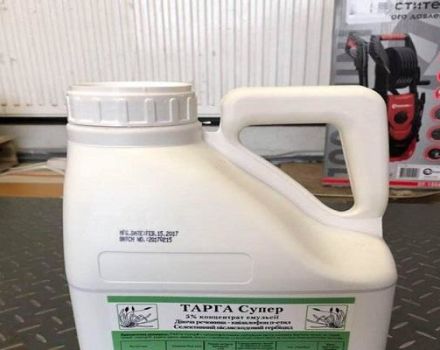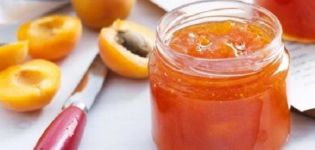Description and characteristics of victoria turkeys, content of crosses
The victoria cross turkeys were bred in Russia, near Stavropol. For breeding, broad-breasted white turkeys were used. The resulting cross is classified as light (weight up to 15 kg) and is intended for growing on farms with small livestock. Consider the description and characteristics of Victoria turkeys, the pros and cons, the technology of keeping and reproduction, feeding and care at home.
Description and characteristics of the Victoria breed
According to the standard, turkeys should be compact in build, with developed muscles, and have a small head relative to the body. The plumage of birds is pure white, without admixture of feathers of other colors. Cross Victoria is distinguished by high egg production, the descendants of the broad-breasted breed lay up to 5 eggs per week. In 4 months, when the females lay, up to 85 eggs can be obtained. The weight of a turkey egg is 85 g. The meat of big cross turkeys has a delicate structure, is fully digestible, not fatty, contains a lot of proteins.
Weight table
Victoria cross turkeys grow quickly, slaughtered at 5 months. The table shows how much they can weigh at this age.
| Age | Males | Females |
| 5 months | 13 Kg | 9 kg |
Adult turkeys left for breeding can put on more weight.
Pros and cons of turkeys
The breed has no other disadvantages.
Growing and keeping
You need to keep Victoria turkeys in a room free for them. The house should not be cold or, conversely, hot, damp and dark, there should be no drafts. The room should have windows, ventilation, artificial lighting. Daylight hours should last 10-12 hours all year round, even in winter. In frosts, it is necessary to provide additional heating, despite the resistance to cold, birds do not like strong cold.
The floor of the house should be covered with straw, sawdust, shavings, hay or peat. The thickness of the bedding layer is at least 15 cm. To prevent pathogenic microflora from multiplying in the bedding material, you need to regularly add a fresh layer.
Cross victoria turkeys love to swim in the sand as they clean their feathers and free themselves from parasites.To do this, in the poultry house you need to put a vessel with sand or dry ash. Representatives of the cross Victoria can sleep on the floor and on perches.
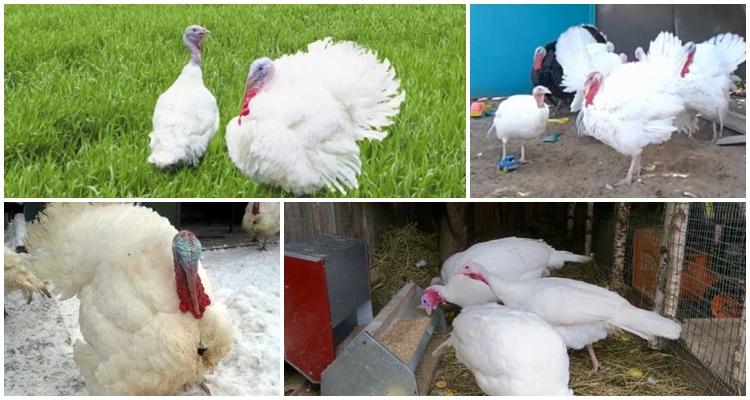
In the poultry house, you need to provide a place for nests where turkeys will lay eggs, a place for feeders and drinkers. The dimensions of the feeders must be calculated based on the fact that each head has a length of 20 cm. It is recommended that drinkers are designed to prevent birds from spilling water, which will make the bedding wet.
How to feed the bird?
The victoria turkey cross belongs to the broiler group. To reap the benefits of an intense metabolism, you need to select a nutritious diet for your birds to gain weight quickly.
You need to feed the turkeys 3 times a day. In the mornings and evenings, give grain mash or mixed feed, in the afternoon - greens. In summer, grass and succulent feed (any vegetables and root crops, substandard and carrion can be used in turkey feed) should make up half of the diet, the rest is grain mixtures. It is necessary to mix oil cake, bran, flour from bones and fish waste to the grain of different varieties. In winter, you need to diversify your food with silage, hay flour, fresh roots and vegetables. Feed with boiled potatoes, add chalk, premixes, salt to the mash. Clean water is required.
Breeding rules
A turkey family can consist of 1 male and a dozen females. Turkeys begin to rush in mid-spring, incubation lasts a month. If the female expresses a desire to sit on the eggs, 18-20 pieces are placed under her.
Good brood hens are obtained from females 2-4 years old, males for breeding should be selected for those who are 2-4 years old.
Victoria turkeys are considered caring hens. They may not even get out of the nest, so you need to make sure that they eat, sometimes for this they must be removed from the nest by force. When the turkey poults hatch, the mothers take care of them responsibly, they can stay with the brood even when the chicks are almost adult.
What you need to know about caring for young animals
After the appearance of Victoria turkeys, they, together with the female, must be transplanted separately, in a small room or corral. This will provide them with protection from other birds, allowing the turkey to calmly teach them everything that is required. The brood of turkeys should be in the fresh air from the first days. Turkey poults are sensitive to a lack of vitamin D, they get it while in the sun.
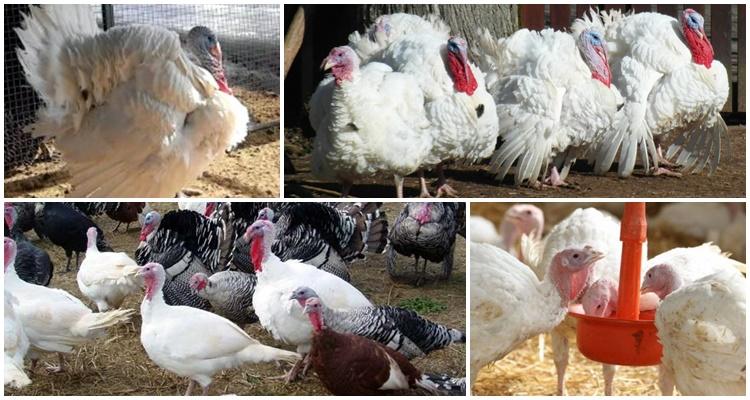
The diet of young turkeys is different from that of an adult bird. First, the chicks are given soft food that they are able to digest - a mixture of boiled chopped eggs, cottage cheese, boiled oatmeal or millet. Greens are added to the mixture. Then grated carrots, zucchini and other vitamin ingredients are gradually added. 6-week-old turkey poults are taught to eat whole grains. The frequency of feeding small turkeys is 6-8 times a day. By 2.5 months of age, the frequency should be reduced to 3 times a day.
If the birds have not finished eating the food, after half an hour it must be removed and water must be supplied. At first, Victoria turkeys should be given only wet mash, but from 3 weeks they should also be taught to dry food. At this age, you can enter into the diet of corn, the most nutritious grain. A separate container in the house should be filled with small stones that the birds need for normal digestion.
Possible diseases
Subject to the required conditions of maintenance, care and feeding, Victoria turkeys rarely get sick.But if they are violated, you can expect infectious diseases, parasitic diseases. Disorders of digestion and metabolic diseases occur due to improper, unbalanced nutritional elements. Novice poultry farmers can make mistakes in drawing up a diet, therefore, even before buying young animals, it is necessary to determine the most useful products and calculate the consumption rate.
Victoria turkeys can be sick with helminth diseases, parasites enter the bird's body from infected relatives, through a dirty litter, soiled with droppings. Therefore, the cleanliness of the litter must be impeccable. The same applies to feeders and drinkers, from where the birds get their food. You need to wash and disinfect equipment every month.
Vaccination is considered to be the prevention of infections in turkeys, it must be done without waiting for the turkeys to get sick. If this has already happened, antibiotic treatment is given. Prevention of helminthiasis - soldering with anthelmintic drugs of young, fattening birds and breeding individuals.
Victoria turkeys and external parasites - lice, fleas, feather eaters can annoy the turkeys. Folk methods of control and prevention - installation of a container with ash or sand in the turkey house. Bathing in them, turkeys clean their feathers and prevent parasites from multiplying. If this does not help, treatment with drugs from lice and feather eaters will save the birds. Moreover, it should affect not only infected birds, but also healthy ones. This is necessary to prevent parasites from spreading in the flock.
The victoria broiler cross is popular with poultry farmers. They note the useful characteristics of turkeys - fast growth, egg production, unpretentiousness. Valuable qualities allow the breed to be in demand at industrial poultry farms, farmers and private poultry owners. Private traders grow turkeys for their own consumption, while farmers grow turkeys for profit from turkey farms.

